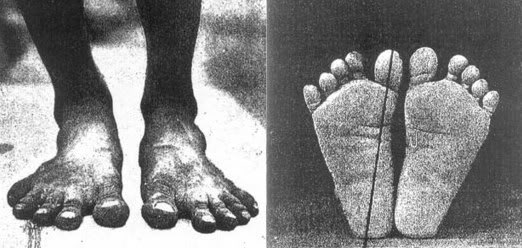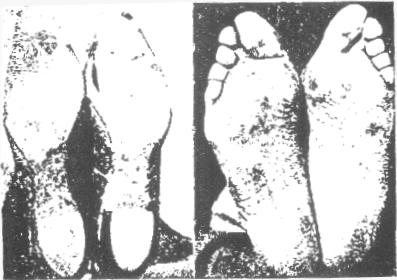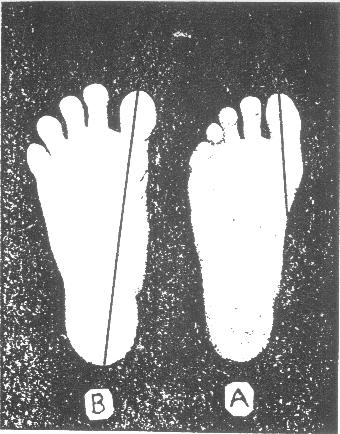Are flat feet genetic? Do people with flat feet face a lifetime of supportive shoes and corrective orthotics? What causes flat feet, exactly?
Actually, about 20% of the American population has so-called “flat feet.” This is defined as a foot that has no discernible medial arch. If you ask a flat footed person to step in paint and then make a footprint on butcher paper, you’ll get an imprint of the entire surface of his foot.
But how do we get flat feet? Many people attribute it – incorrectly, in my opinion – to genetics. If your parents had flat feet, you will, too.
The reality is that we’re all born with flat feet. Arches are created, not born. We develop our arches by standing and walking on our feet, preferably barefoot. When shoes enter into the picture, that’s when things get a little caddywompus.
Back in 1905, Dr. Philip Hoffman did a survey comparing the feet of people who wear shoes to those of people who grew up barefoot. The study was published in the American Journal of Orthopedic Surgery. Fortunately for us, Hoffman also took a lot of photographs to illustrate his point.
Exhibit A – The feet of a non-shoe-wearing native hominid (or, in plain English, a barefoot person)

As you can see, this person’s feet look a bit like hands with the toes splayed wide and lots of space between each digit. Also, note the line drawn through the foot on the right; it runs directly from the big toe through the heel.
If we compare this to the feet of a shod person, or someone who’s worn shoes their whole life, we can see a massive difference:

Notice how the feet in this photo have taken on the shape of the shoes and there is no direct line from the big toe to the heel. How do you think this affects the functionality of the foot, let alone balance? Not so good.
Even more disturbing is the fact that shoes make this change to our feet relatively quickly. Here’s a photo showing a comparison between an adult who has never worn shoes and a child who has only had shoes on for 3 months. 90 days is all it takes to completely inhibit the natural function of your feet!

Researchers in India found that wearing shoes before the age of 6 is correlated with a higher incidence of flat feet. 8.2% of children who wore shoes had flat feet compared with 2.8% of children who ran around barefoot.
So, if it seems that shoes are the root cause of flat feet, why are flat footed people constantly hearing recommendations for arch supports, orthotics and other foot-altering technology?
The reality is that we’re a shoe wearing society (why we wear them is beyond me…what’s the first thing you kick off when you get home and are ready to relax?). We also love technology, and thanks to Nike, we’re conditioned to believe that our feet need tiny pillows under them to function properly.
Also, there’s no financial investment in the advice to “just” strengthen your feet, no $100 sneakers or constantly changing custom orthotics to purchase. When you put your feet into these supportive devices, however, it’s like putting your arches in a wheel chair. The orthotics do all the work and the muscles of your feet become flaccid.
Your arches are meant to expand and contract with every step. They’re built in shock absorbers, plus they launch you forward as you walk, making your gate much more efficient.
Orthotics, arch supports, sneakers and shoe inserts make you feel better temporarily. Collapsed arches are correlated to collapse through the core, so giving your feet a lift will result in you feeling lighter…as long as you’re standing still. The problem is, as soon as you take a step, your arch’s natural function is inhibited, meaning you have to compensate with other, less efficient muscles.
This contributes to tight quads and hip flexors, which cause lower back pain…but before I go on a rant about the importance of the foot in postural health, let’s take a look at what you can do to strengthen your flat feet and avoid the money pit of built-up footwear.
First, and most importantly, ditch any footwear that is is stiff, inflexible or provides arch support in any way, shape or form. While you’re at it, toss out your high heels (okay, you can keep a few pairs for special occasions, but if you’re serious about fixing your flat feet, you’ll want to stay as close to barefoot as you can 98% of the time). This includes, but is not limited to, the ugliest shoes on earth, Dansko clogs.
Despite their clever branding and endorsements by nurses in hospitals everywhere (who, despite their numerous and admiral medical accomplishments, have zero training in posture or structural function), these are perhaps the worst shoes you could possibly wear. Not only do they not bend, they also have a molded foot bed that promotes inversion of your transverse arch which makes natural toe function completely impossible. 100% of my clients with lower back pain have inverted transverse arches.
Next, go barefoot as often as you can! Going barefoot is the best way to stimulate the sensory perception on the bottoms of your feet, which in turn causes different muscles in your lower legs to fire. These muscles are the ones that support your medial arch, so as you wake them up, your arch will also come alive.
Walking barefoot in sand is great extra credit because it’s an ever changing surface and causes you to flex, extend, invert and evert your foot. These movements will stimulate the proprioceptors in your ankle joint, which will in turn cause your posture to shift for the better without you having to do any additional exercises or training.
Once you’ve instituted these first two changes, you can start strengthening your feet with specific drills. Spreading your toes as far apart as you can is one way to flex your foot muscles. Hold the stretch for as long as you can. If you can’t spread your toes (like me when I first started this), check out Yoga Toes. It’s a great aid to use until you have a little more control over your foot movement.
Another fantastic arch builder is to use your toes to pick things up and move them. Try spreading a bunch of marbles on the floor and put a bowl next to the marbles. Using your toes, pick up the marbles and drop them into the bowl. This promotes dexterity and strength in your foot.
You can also try standing on your toes for periods of 30 seconds to a minute. Most of us have weak toes because, as you can see in the pictures above, our shoes squish our feet together and make toe function difficult. Standing on your toes will, again, wake up the sensory perception and get the muscles of your feet firing differently.
[sc name=”ppfl-cta”]